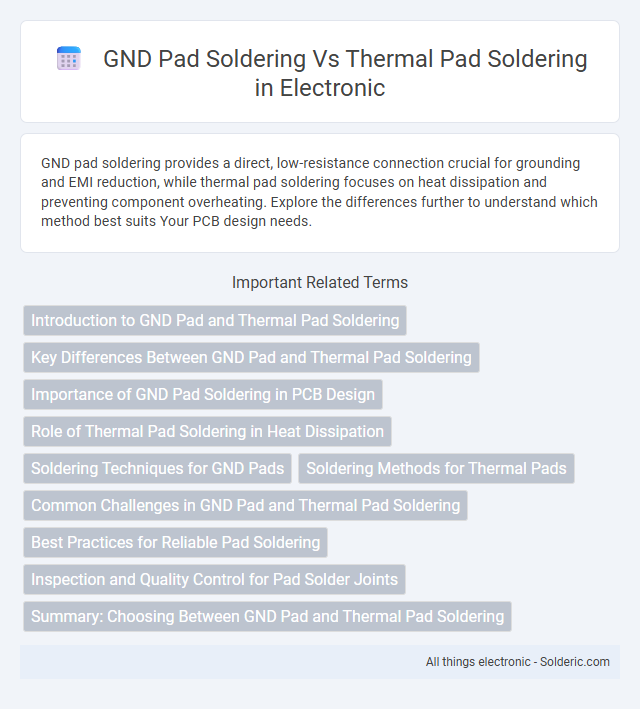GND pad soldering provides a direct, low-resistance connection crucial for grounding and EMI reduction, while thermal pad soldering focuses on heat dissipation and preventing component overheating. Explore the differences further to understand which method best suits Your PCB design needs.
Comparison Table
| Aspect | GND Pad Soldering | Thermal Pad Soldering |
|---|---|---|
| Definition | Soldering directly on the ground (GND) pad of a PCB component. | Soldering on a large exposed thermal pad designed for heat dissipation. |
| Primary Purpose | Provides electrical ground connection. | Ensures thermal conduction for heat dissipation. |
| Heat Dissipation | Limited; mainly electrical grounding. | High; improves component thermal management. |
| Pad Size | Relatively small, focused on signal ground. | Large, designed for effective heat transfer. |
| Soldering Difficulty | Generally easier due to smaller size. | More challenging due to large area and heat transfer. |
| Applications | Common in signal grounding and standard PCB layouts. | Used in power devices, high-current components, and thermal management. |
| Thermal Resistance | Higher thermal resistance, less efficient heat removal. | Lower thermal resistance, efficient heat removal. |
| Reliability | Good for electrical connection; moderate thermal stress tolerance. | Improves reliability by reducing thermal stress on components. |
Introduction to GND Pad and Thermal Pad Soldering
GND pad soldering involves connecting the ground pad on a PCB to ensure a stable electrical reference and effective heat dissipation for components. Thermal pad soldering focuses on attaching the thermal pad, which enhances heat transfer away from the component to prevent overheating and improve reliability. Your choice between GND pad and thermal pad soldering impacts both electrical performance and thermal management of the device.
Key Differences Between GND Pad and Thermal Pad Soldering
GND pad soldering primarily involves connecting the ground plane to enhance electrical stability and reduce noise, while thermal pad soldering focuses on efficient heat dissipation from power components to the PCB. GND pads are usually smaller and designed for signal reference, whereas thermal pads are larger with multiple vias to facilitate heat transfer. Proper soldering techniques for GND pads emphasize minimizing resistance and ensuring solid electrical contact, whereas thermal pad soldering requires optimal thermal conductivity and void-free solder joints to prevent overheating.
Importance of GND Pad Soldering in PCB Design
GND pad soldering is crucial in PCB design due to its role in establishing a reliable electrical ground connection that minimizes noise and enhances signal integrity. Proper soldering of the GND pad ensures effective heat dissipation, preventing thermal buildup and improving component longevity. Thermal pad soldering primarily focuses on heat transfer, but insufficient attention to the GND pad can compromise circuit performance and electromagnetic compatibility (EMC).
Role of Thermal Pad Soldering in Heat Dissipation
Thermal pad soldering plays a crucial role in heat dissipation by creating a direct thermal pathway between the component and the PCB, facilitating efficient transfer of heat away from sensitive components. Unlike GND pad soldering, which primarily ensures electrical grounding, thermal pad soldering uses solder to enhance heat conduction and reduce hotspot formation. Efficient thermal pad soldering improves component reliability and performance by maintaining optimal operating temperatures.
Soldering Techniques for GND Pads
Soldering techniques for GND pads emphasize achieving a low-resistance, reliable electrical connection essential for grounding and heat dissipation. Utilizing a thermal pad with multiple vias and optimized solder paste stencil thickness ensures consistent solder joints and minimizes thermal stress during reflow. Proper alignment, controlled solder volume, and precise temperature profiles are critical to prevent solder bridging and maintain the integrity of both electrical and thermal performance.
Soldering Methods for Thermal Pads
Soldering methods for thermal pads typically involve reflow soldering, which ensures a uniform and reliable thermal connection by evenly melting the solder paste beneath the pad. Unlike traditional GND pad soldering, thermal pad soldering requires precise control of temperature profiles to avoid thermal stress and ensure optimal heat dissipation. Your PCB design benefits from these methods by improving thermal conductivity and mechanical stability, enhancing overall device performance.
Common Challenges in GND Pad and Thermal Pad Soldering
Common challenges in GND pad soldering include ensuring proper heat dissipation and achieving a strong mechanical bond while avoiding solder bridging or insufficient solder joints. Thermal pad soldering often faces difficulties with uniform heat distribution and preventing voids beneath the pad, which can affect thermal conductivity and device reliability. Your soldering process must address these issues through precise temperature control and optimized pad design to ensure robust electrical and thermal connections.
Best Practices for Reliable Pad Soldering
Best practices for reliable GND pad soldering emphasize ensuring a clean, oxidant-free surface with optimal pad size to facilitate strong mechanical and electrical connections. Thermal pad soldering requires precise temperature control and appropriate solder paste application to prevent thermal damage while maintaining efficient heat dissipation. Utilizing reflow profiles tailored to the specific PCB materials and components enhances solder joint integrity and overall circuit reliability.
Inspection and Quality Control for Pad Solder Joints
Inspection and quality control of GND pad soldering involves precise monitoring of solder joint uniformity and thermal dissipation to ensure reliable electrical grounding. Thermal pad soldering requires detailed assessment of heat distribution and solder coverage to prevent voids and enhance thermal conductivity for efficient device performance. You can improve both methods by implementing automated optical inspection (AOI) and X-ray analysis to detect hidden defects and ensure consistent solder joint integrity.
Summary: Choosing Between GND Pad and Thermal Pad Soldering
GND pad soldering ensures a direct electrical connection to ground, improving signal integrity and reducing electromagnetic interference in your PCB design. Thermal pad soldering enhances heat dissipation by providing a large solder area that spreads heat away from components, crucial for thermal management in high-power applications. Choosing between GND pad and thermal pad soldering depends on whether your priority is electrical grounding or efficient heat transfer to maintain component performance.
GND pad soldering vs thermal pad soldering Infographic

 solderic.com
solderic.com